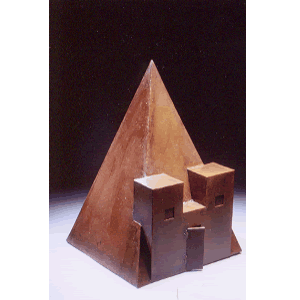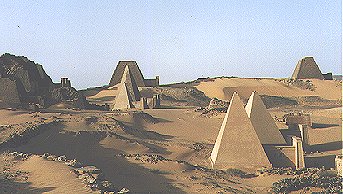
"Pyramid, Meroë, Sudan."
Steel. 1999.
36" x 26" x 24"
|
 |
Subject
The
Kingdom of Kush (derived from the Egyptian name for Nubia ) emerged
in the Sudan after the collapse of the New Kingdom in Egypt, which
it conquered in 760 B.C. The Kush pyramids of Meroë date from
this time to AD 320, and were inspired by Egyptian non-royal pyramids
of the New Kingdom, specifically those at Deir el-Medinah ( 1300
- 1100 BC ).
In the Meroë region, there are more than 50 such pyramids usually
20 - 25m high with sides at a 70 degree incline. On the eastern
side of each pyramid, there is an antechamber for sacrifices. The
burial chamber, with its own antechamber, is below the pyramid with
an entrance substantially in front of the pyramid's antechamber.
Object
The
image is actually a composite of two pyramids, and a result of a
mistake in reading an image. The reference for the sculpture was
the book "Egypt: From Prehistory to the Romans", by Dietrich Windung
( Taschen ). Page 42, presents two images of steep pyramids: one
from Deir el-Medinah, and the other from Meroë. Reading the
Meroë image, it appeared that the front pillars abutted the
pyramid, as in the case of the Egyptian pyramid. However, this was
an illusion of the photograph. Subsequent research proved that the
pillars belonged to a temple-style antechamber. However, the visual
image was so strong that I decided to retain the merged image.
Further Information:
There
is little information about Meroë. However, the following may
be of interest:
- Wildung,
Dietrich. Egypt : From Prehistory to the Romans. Taschen.
July 1997. ISBN: 3822882526
- http://www.the-spoiler.com/Sinjin/
INDY/itext12.html
- http://www-oi.uchicago.edu/OI/PROJ/NUB/Nubia.html
|
|
